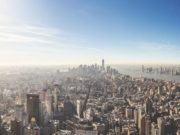Citi Wealth Paper 2023: $84.4 Trillion Wealth Transfer Till 2045, $72.6 Trillion to Heirs, $11.9 Trillion to Charities, 70% of Heirs to Change Advisor Post-Wealth Transfer from Parents
28th July 2023 | Hong Kong
Citi has released the Citi Wealth Paper 2023, providing key insights into wealth management, private banking, wealth transfer & investor preferences. $84.4 trillion of wealth expected to be transferred to the next generation till 2045, with $72.6 trillion to heirs and $11.9 trillion to charities. 70% of heirs are expected to change their family advisors post-wealth transfer from parents. Individual investors AUM (Assets under Management) accounted for 52% of global AUM in 2021, and is expected to growth to 61% of global AUM by 2030. The 4 Key Investors Trends are Rise of retail, New wealth, New wave of investors, Expanding investment universe and 2 Key Investors group are Inter-generational wealth transfer, and Increased share of wealth held by women. The Top 5 Investment Products by client interests are Equities, Fixed Income, Commodities, ETFs, Private Assets. Investors are interested in low-margin products (single asset equities, fixed income, and commodities, as well as Exchange-Traded Funds / ETFs) and less interested in those products with high margin / fees for private banks (e.g., model portfolios) or real assets. ETF AUM $8.9 trillion (Exchange-traded funds, +13% growth yearly for 5 years), Index mutual funds AUM $6.9 trillion (+8% growth yearly for 5 years), Active mutual funds AUM $37.3 trillion (+3% growth yearly for 5 years). On Private Assets – UHNW and family offices have a relatively high allocation to alternatives of 45% on average, Retail investors tend to have an allocation of just between 3% to 4.5% depending on age group. On Digital Assets – Sentiment was muted around the offering of cryptocurrency through wealth platforms, underlying technology including distributed ledger technology (DLT) and tokenization (majority of interviewees have shown interest, compared to cryptocurrencies). On ESG – 2/3 of millennial and Gen Z investors are concerned about environmental and social issues such as carbon emissions and income inequality. Limited interest in ESG overall, divergence between younger investors and older investors. Difficulty in determining which ESG offerings were truly sustainable and the potential for misinformation. On Education & Sources of Information – Younger generations acquiring an increased amount of investment knowledge from a broader range of sources, rather than solely relying on a financial professional for investment ideas. Target to Grow UHNW & HNW Segment – 44% (UHNW: 18%, HNW: 26%). Target to Grow Family Office Segment – 8%. The Top 5 Challenges to Growth (Wealth Management) – Regulations, Fee & Margin Pressure, Digital Disruption, Geopolitics, Cyberthreats. The 5 Regulatory Landscape Impacting Wealth Industry are Sanctions, Tax regulations, Changes to market infrastructure, On-shoring regulations, Digital assets regulations. See below for summary key findings.
“ $84.4 Trillion Wealth Transfer Till 2045, $72.6 Trillion to Heirs, $11.9 Trillion to Charities, 70% of Heirs to Change Advisor Post-Wealth Transfer from Parents “
Okan Pekin, Citi’s Global Head of Securities Services: ““The emergence of new technologies demands for a native digital client experience and the largest intergenerational wealth transfer in history pose significant challenges to the entire wealth industry. Our research outlines ways in which we can re-imagine service and operating models to deliver solutions to wealth managers to address these challenges.”
Andrew Pitt, Head of Research and Content for Citi’s Institutional Client Group: “Based on our study, it is clear that the wealth industry is at an inflection point, and it is critical that wealth management providers servicing the mass affluent to ultra-high net worth clients need to get their operating model right. Moving forward, we see trusted partnerships as key to success as consolidation continues.”
Citi Wealth Paper 2023

Citi has released the Citi Wealth Paper 2023, providing key insights into wealth management, private banking, wealth transfer & investor preferences.
By Firms
- Global Bank – Wealth / Private Bank – 30%
- Non-Global Banks – Wealth / Private Bank – 35%
- Retail Bank – 9%
- FinTech (Wealth) – 22%
- Global Asset Manager – 4%
By Firm Type
- Bank (Retail Wealth) – 22%
- Private Bank – 20%
- Securities Services Providers – 17%
- Retail Broker – 13%
- FinTech Provider – 10%
- Wealth Platform – 8%
- Consultant – 8%
- Other – 2%
Summary:
- Inter-generational Wealth Transfer – $84.4 trillion (till 2045), Transfer of $72.6 trillion to heirs and $11.9 trillion to charities
- Change of Advisor Post-Wealth Transfer – Over 70% of heirs are likely to change or discontinue the relationship with their family advisor post wealth transfer from parents.
- 4 Key Investors Trends – Rise of retail, New wealth, New wave of investors, Expanding investment universe
- 2 Key Investors Group – Intergenerational wealth transfer, Increased share of wealth held by women
- Individual investors AUM – Accounted for 52% of global AUM in 2021 (61% of global AUM by 2030)
- Top 5 Investment Products by Client Interests – Equities, Fixed Income, Commodities, ETFs, Private Assets
- Digital Orientation – Younger generations are digitally native and expect a digitized, seamless and efficient service.
- Education & Sources of Information – Younger generations acquiring an increased amount of investment knowledge from a broader range of sources, rather than solely relying on a financial professional for investment ideas.
- ESG – 2/3 of millennial and Gen Z investors are concerned about environmental and social issues such as carbon emissions and income inequality.
- ESG investments – Limited interest in ESG overall, divergence between younger investors and older investors. Difficulty in determining which ESG offerings were truly sustainable and the potential for misinformation.
- Expanding Investment Universe – Investors interested in low-margin products (single asset equities, fixed income, and commodities, as well as Exchange-Traded Funds / ETFs) and less interested in those products with high margin / fees for private banks (e.g., model portfolios) or real assets
- ETF AUM – $8.9 trillion (+13% growth yearly for 5 years)
- Index mutual funds AUM – $6.9 trillion (+8% growth yearly for 5 years)
- Active mutual funds AUM – $37.3 trillion (+3% growth yearly for 5 years)
- Private Assets – UHNW and family offices have a relatively high allocation to alternatives of 45% on average, Retail investors tend to have an allocation of just between 3-4.5% depending on age group
- Digital Assets – Sentiment was muted around the offering of cryptocurrency through wealth platforms, underlying technology including distributed ledger technology (DLT) and tokenization (majority of interviewees have shown interest, compared to cryptocurrencies)
- Target to Grow UHNW & HNW Segment – 44% (UHNW: 18%, HNW: 26%)
- Target to Grow Family Office Segment – 8%
- Target to Grow Mass Affluent Segment – 26%
- Target to Grow Retail Segment – 17%
- Top 5 Challenges to Growth (Wealth Management) – Regulations, Fee & Margin Pressure, Digital Disruption, Geopolitics, Cyberthreats
- Top 5 Challenges to Adopting Digital Assets (Wealth Management) – Cybersecurity, regulatory barriers, financial infrastructure, legacy processes & systems
- 5 Regulatory Landscape Impacting Wealth Industry – Sanctions, Tax regulations, Changes to market infrastructure, On-shoring regulations, Digital assets regulations
- Top 5 Already Outsourced or Likely to Consider Outsourcing (Wealth Management) – Post-trade services, Trading & execution, Client services & reporting & data, Core operational functions, Onboarding & KYC
- Top 5 Will Never or Unlikely to Outsource (Wealth Management) – Onboarding & KYC, Compliance & regulatory & tax reporting, Treasury & cash management, Core operational functions, Client services & reporting & data
Citi Wealth Paper 2023 Survey
1) Target Growth Segment For Firms
- High Net Worth* – 26%
- Mass Affluent – 19%
- Ultra-High Net Worth* – 18%
- Retail – 17%
- Other (Including Institutional) – 12%
- Family Offices – 8%
*Total HNW & UHNW – 44%
2) Investment Products – By Client Interests:
- Equities, Fixed Income, Commodities – 87%
- ETFs – 70%
- Private Assets – 56%
- ESG – 33%
- Digital Securities, Cryptocurrencies, Tokenized Assets – 31%
- Securities Lending – 23%
- Model Portfolios – 22%
- Real Assets – 22%
3) Adopting Digital Assets Challenges:
- 71% cybersecurity
- 63% regulatory barriers
- 62% financial infrastructure
- 50% legacy processes & systems
4) Top Challenges to the Industry / Firm’s Growth Strategy:
- Regulations – 68% / 69%
- Fee & Margin Pressure – 61% / 59%
- Digital Disruption – 46% / 51%
- Geopolitics – 38% / 37%
- Cyberthreats – 37% / 31%
- End of Life Technology – 27% / 33%
- Intergenerational Wealth Transfer – 23% / 25%
5) Regulatory Landscape Impacting Wealth Industry:
- Sanctions
- Tax regulations
- Changes to market infrastructure
- On-shoring regulations
- Digital assets regulations
6) Top Priorities in the Short & Medium-Term:
- Client experience – 71%
- Client growth (include segment expansion) – 52%
- Cost & revenue – 46%
- Digital transformation – 46%
- Regulations & compliance – 45%
- New products & solutions – 31%
- Geographical expansion – 7%
7) Top Areas of Focus to Improve your Client Experience:
- Digital client experience (instruction, research, data & reporting) – 80%
- Onboarding / KYC – 61%
- Partnership & Microservices (eg. global advisory) – 30%
- Client service models (chatbots, language & location strategy) – 28%
8) Already Outsourced or Likely to Consider Outsourcing:
- Post-trade services – 65%
- Trading & execution – 43%
- Client services, reporting & data – 34%
- Core operational functions – 31%
- Onboarding & KYC – 29%
- Compliance, regulatory, tax reporting – 29%
- Treasury & cash management – 29%
9) Will Never or Unlikely to Outsource:
- Onboarding & KYC – 55%
- Compliance, regulatory, tax reporting – 54%
- Treasury & cash management – 54%
- Core operational functions – 51%
- Client services, reporting & data – 50%
- Trading & execution – 43%
- Post-trade services – 21%
10) Top 3 Considerations for Trading Partnership Strategy:
- Guaranteed best execution – 71%
- End-to-end operating model (streamline execution, clearing, settlement, custody) – 66%
- Access to innovative technology to facilitate ease of trading – 54%
- Brand & reputation of outsourced provider – 44%
- Entering new markets with ease – 32%
- Access to new, different products, asset classes – 29%
11) Preferred technology development strategy
- In-house – 25%
- Hybrid (External & In-house) – 67%
- Fully outsourced – 8%
Citi Wealth Paper 2023 – Key Findings
1) Background
- Retail wealth, wealth management and private banking industry at an inflection point.
- Massive infusion of liquidity into global financial markets during COVID crisis, much of liquidity found its way into the wealth ecosystem.
- AUM (Assets Under management) increased significantly, trading activity grew quickly
- Exposure to new products and solutions democratized access to markets in new and innovative ways.
- Evolution of technology enabled retail investors to trade financial products from mobile applications, leading to changed expectations for a digitized client experience.
- Emergence of retail disrupters has begun to dis-intermediate some of the larger existing players and strained legacy fee models.
- Drive for scale and efficiency asset management accelerates consolidation across the entire wealth industry.
- Wealth players need to address issues around cost & margin pressures, increasing regulatory complexity, and rapidly evolving demands for an enhanced and digitized client experience.
- Challenges involves grappling with legacy technology, stretched investment budgets and optimize front to back-end operating models to deliver enhanced client experience.
- Citi Securities Services deliver post-trade solutions that address these problems, supporting clients on transformation journey.
2) Client – Trade Journey
- Account Accounting – Onboarding, KYC
- Receiving Portfolio Advice – Research & Commentary, Market News
- Executing Investments* – Trade Execution, Clearing, Post-Trade Settlement
- Accessing Portfolio Information – Reporting, Monitoring Positions & Risk Management, Value-add Analytics
- Personalised Product & Service Updates
*Executing Investments (Bank & Custodian Service):
- Trade Execution – Equities, fixed income, commodities, ETFs, private assets, real assets, digital assets, discretionary portfolios, ESG, securities lending, model portfolio
- Clearing – Cash clearing, ETF clearing, OTC clearing, Trade reporting & confirmations
- Post-Trade Settlement – settlement & reconciliations, safekeeping, asset servicing (eg. client reporting, regulatory reporting)
3) Key Trends
A) Wealth industry prepares for long-term change:
- Technology has been focused on front-end revenue generating activities.
- Critical post-trade & back-end processes reliant on a patchwork of manual or outdated technological processes, using systems and data definitions that can vary widely within firms.
- Acceleration of digitalization, market volatility, fluid regulatory landscape, emerging technologies, great wealth transfer and changing client behaviour & expectations
- Uncertainty around revenue and growth, broader approach to business and operational transformation for private banks and wealth managers.
- Strong focus on the transformation of post-trade services
- Wealth managers are looking to enhance cost and operational efficiency, transparency, and regulatory compliance to continue focusing on core services, providing a high quality & seamless client experience.
B) Macroeconomic and Geopolitical Environment:
- Uncertainties of Global Growth, Inflation and Geopolitical Tension Cause Concerns – tightening margins and building cost pressures, uncertain investment outlook hastened the evolution of client demands for new products and services with expectations for a seamless digital and hybrid experience.
- Geopolitical Environment Remains Challenging – Possible reconfigurations and fresh disruptions of supply chains, capital flows, and payment systems remain a threat, heightened volatility for markets and impact economic activities ahead, need to seek a stable & geographically diversified partner to help them manage cross-border risk and complexities
- Fluid Regulatory Environment Adds Difficulties – regulations as the industry’s top challenge in the short & medium-term, regulations as one of the top 3 external challenges to their firm’s growth strategy, compliance requirements has become increasingly costly and difficult across different regulatory regimes and multiple technology systems and tools.
- Recent Bank Fallouts Expose the Industry’s Vulnerabilities – Scale and speed at which the recent bank fallouts unfolded in March 2023 caught the world off guard, banks involved suffered significant outflows within extremely short periods of time. Digitalization of the financial industry has made it much easier for clients to diversify their accounts among multiple providers, shuffle their allocations, or even switch away from one provider entirely with just a few clicks. Unprecedented mobility and flightiness of client assets enabled by digitalization is forcing the wealth industry to accelerate their roadmap to change. Long-standing structural shifts and trends are also complicating strategic decision making for the wealth industry.
C) Demographic Shifts & Expanding Investment Universe:
- Rise of retail
- Emergence of new wealth
- New wave of investors
- Expanding investment universe
D) Rise of Retail:
- Individual investors accounted for 52% of global AUM in 2021
- Individual investors expected to grow to 61% of global AUM by 2030
- Boom in retail trading driven by easier access to investment information and online forums
- In January 2021, a large group of retail investors using an internet forum led the short squeeze of GameStop’s stock and caused significant losses for a number of hedge funds, demonstrating the power of retail investors and their ability to actually move the market.
- With rise of AUM share of retail investors, new opportunities for wealth managers to expand vertically into retail by providing institutional grade products & services (emerging technologies have made it more economically feasible to do so by personalizing at scale)
E) New Sources of Wealth Are Emerging Around the Globe:
- Household wealth in APAC is expected to grow at a CAGR of 7.2% from 2022-2026, versus 4.3% in Europe and 4.4% in North America.
- Investors in Asia behave differently to those in the traditional Western markets.
- Asian markets are more digitally oriented and open to new digital tools.
- Adoption of digital technologies in financial services has evolved much more quickly in Asia
- A few interviewees with global operation are looking to tap into new sources of wealth in Asian markets such as India and Singapore
- Those without an existing global presence prefer to focus solely on home markets within the same regulatory regime.
- Only 7% of survey respondents listed geographical expansion in their top three short- to medium-term priorities, reflective of cost & time pressures involved in establishing a presence in a new country. Wealth managers and private banks can use an offshore franchise or provide funds via other managers in regions where they do not have sufficient trust or expertise.
F) Wealth is Being Transferred to New Investors:
- Intergenerational wealth transfer
- Increased share of wealth held by women
G) The Intergenerational Wealth Transfer:
- Wealth transfers through 2045 are projected to total $84.4 trillion
- Transfer of $72.6 trillion to heirs and $11.9 trillion to charities
- Over 70% of heirs are likely to change or discontinue the relationship with their family advisor post wealth transfer from parents.
- Maintaining sticky relationships across generations is key to securing a solid asset and customer base.
3 key differentiators define the next generation:
- More digitally oriented
- Greater access to information and education around investing overall and at an earlier age
- Greater focus on newer asset types and genres including ESG and digital assets.
H) Digital Orientation
- Younger generations are digitally native and expect a digitized, seamless and efficient service.
- Generation Y and Z in the US have a significant preference to apps over websites compared to generation X, baby-boomers, and pre-boomers.
I) Education & Sources of Information
- Younger generations acquiring an increased amount of investment knowledge from a broader range of sources, rather than solely relying on a financial professional for investment ideas.
- In United States, 60% of those aged 18-34 use social media as a source of investment advice compared to just 8% of those aged 55+.
- Younger investors were more likely to invest in riskier instruments such as options or “meme stocks.”
J) ESG and Digital Assets
- Younger generations are broadening the scope of their investments with ESG and digital assets.
- 2/3 of millennial and Gen Z investors are concerned about environmental and social issues such as carbon emissions and income inequality.
- 2/3 of investors 58 years old and older say they are only somewhat or not at all concerned.
- UNHW next gens expect 43% of their portfolio to be allocated to sustainability in 5 years compared to 17% (now). Younger investors care more about specific ESG issues such climate change, biodiversity, and gender equality.
- Younger generations also have a greater interest in digital assets. 45% and 46% of Millennials and Gen Zs respectively would like cryptocurrency to be an investment option for their 401(k), compared to 31% of Gen Xs and 11% of Boomers.
- Interest in ESG and digital assets appears to be a potential gateway into investing for younger generations.
- 44% of Gen Z investors in the US made their first investments into crypto.
K) Women Will Hold an Increasing Share of Wealth
- Women increasingly occupy higher paying jobs, accumulate wealth and invest more
- Female investors may differ from the traditional investor by being more risk averse, caring more about ESG and are also more likely to seek help in investing.
L) The Expanding Investment Universe
- Expanding number of investable assets within wealth management
- Investors appear to be overwhelmingly interested in low-margin products (single asset equities, fixed income, and commodities, as well as Exchange-Traded Funds / ETFs) and less interested in those products with high margin / fees for private banks (e.g., model portfolios) or real assets
- Potential offerings in ESG, private markets and digital assets
M) Low-Margin Products
- Changing relationship between investment alpha and beta
- Ability of many managers to consistently deliver investment returns in excess of a benchmark had proven to be challenging
- Significant proportion of active managers delivered index performance while charging active fee levels
- In earlier decades, managers were able to deliver outperformance using tilts toward particular characteristics, naming them style boxes, smart beta or in their more recent iteration – factor tilts. These can now be replicated by indices (Eg. BlackRock’s Aladdin, State Street’s Alpha, or Amundi’s ALTO).
- In United States, index portfolios now account 24% (2022) of professionally managed assets (2015: 18%)
- Wealth and retail investors have moved to index portfolio allocations due to the lower fee levels
- ETFs benefited from investor shift to index products.
- End-2022, ETF AUM was at $8.9 trillion (+13% growth yearly for 5 years)
- Index mutual funds AUM at $6.9 trillion (+8% growth yearly for 5 years)
- Active mutual funds AUM at $37.3 trillion (+3% growth yearly for 5 years)
- Tax efficiency is often listed as one of the main reasons for increasing ETF adoption
N) Private Assets
- Private assets present attractive opportunities for the wealth management industry
- UHNW and family offices have a relatively high allocation to alternatives of 45% on average
- Retail investors tend to have an allocation of just between 3% to 4.5% depending on age group
- Opportunity gap between retail and institutional investors in terms of access to private assets.
- 98% of the US population are restricted from investing directly in private equity funds due to regulations and high investment minimums.
- Underperformance of retail portfolios, as private equity has outperformed public equity in the past 20 years
- Demand for private assets from wealth customers is increasing.
- Value proposition may appear clearer as compared to ESG and digital assets, but obstacles to adoption such as data inconsistency and regulatory uncertainty remain when incorporating these products into platforms and offerings.
O) Digital Assets:
1) Cryptocurrencies
2) Underlying technology including distributed ledger technology (DLT) and tokenization (majority of interviewees have shown interest, compared to cryptocurrencies)
- Sentiment was muted around the offering of cryptocurrency through wealth platforms, with concerns voiced around the lack of regulatory clarity and potentially insufficient demand from clients
- Interviewees believe cryptocurrencies are at an early stage of broad adoption and building trust and confidence in this asset class as well as recognizing it as a mainstream financial asset, is difficult in the current environment post the collapse of FTX.
- In Asia, more openness to digital assets, but in most regions, wealth managers are building teams to be “fast followers” of developments in the space, rather than leading the innovation as a “first mover.”
- Potential opportunities and a value proposition with the use of tokenization, particularly in conjunction with private assets
- Citi estimates that by 2030 tokenization in private markets will grow by 80x and reach a value of nearly $4 trillion.
- Tokenization may have multiple benefits for illiquid assets including greater liquidity and accessibility from fractionalization, cost efficiencies and enhanced transparency.
- Digital assets may have the potential to unlock significant value for wealth managers, challenges remain over adoption, particularly from an operational and regulatory standpoint.
- Adoption of blockchain technology remains difficult in a fragmented financial system
- Commitment required to adopt digital assets, combined with hesitancy around demand and the lack of regulatory clarity, creates challenges for wealth managers seeking to add digital assets to their ecosystem.
P) ESG:
- Survey results reflected limited interest in ESG overall, divergence between younger investors and older investors
- ESG as a long-term trend particularly as a growing focus for next gens, of which over half are already investing sustainably.
- Difficulty in determining which ESG offerings were truly sustainable and the potential for misinformation.
- In Europe – 61% of investors from the affluent to UHNW question if sustainable investments are credible and worry about the potential for funds to be greenwashed.
- Lack of consistency and availability of data and clear KPIs in ESG reporting
- Gap in both clients’ and advisors’ ESG-related knowledge
- Clients need to be sufficiently educated and equipped to be able to express their ESG preferences to advisors
- Advisors need to have the necessary expertise and understanding to select and curate an appropriate ESG offering based on these preferences.
- Education and information gaps need to be narrowed so that the wealth industry can better service client needs with regards to ESG.
- Difficult to develop appropriate products in current market conditions
- Managers still need to dedicate resources to build out their ESG offerings to capture long-term trends
4) Challenges & Considerations for the Wealth Industry
Top 3 Challenges to the Industry / Firm’s Growth Strategy:
- Regulations – 68% / 69%
- Fee & Margin Pressure – 61% / 59%
- Digital Disruption – 46% / 51%
- Geopolitics – 38% / 37%
- Cyberthreats – 37% / 31%
- End of Life Technology – 27% / 33%
- Intergenerational Wealth Transfer – 23% / 25%
Regulatory landscape impacting the wealth industry:
- Sanctions
- Tax regulations
- Changes to market infrastructure
- On-shoring regulations
5) Digital assets regulations
Fee & Margin Pressure:
- Financial information and the various direct-to-consumer digital financial planning and advisory tools become more easily accessible, value of advisory and investment expertise has changed
- Industry has also seen the shift away from active to passive and self-directed products which has contributed to the overall depression of fees.
- Essential for companies to simplify their operating models, streamline operations, and cut costs
- Problem is compounded by increasingly complicated and fragmented regulatory requirements, difficult for those firms that run global businesses supporting cross-border and onshore investments.
Digital Disruptions:
- Newer, nimbler, and more technology-enabled entrants are delivering a more seamless and user-friendly client experience
- Use of digital trading platforms, mobile money management and robo-advisory services are also expected to grow.
- Customer retention was the top cited benefit from digital transformation, above cost savings.
- FinTech firms and non-financial companies with strong technological capabilities may be considered a threat as they cross over into the middle ground by launching capabilities typically offered by wealth managers.
- Threat to the wealth management industry is the deployment of direct-to-consumer AI technologies
- Trust and relationships are crucial parts of wealth offerings, barriers for digital disruptors to capture broad market share.
- Partnerships between traditional players and FinTech firms may allow for the provision of both trustworthiness and a seamless experience, with technology and innovation from newer firms complementing the reputation and security provided by traditional institutions.
- Future leaders in the wealth industry will likely be established players that combine the best of both worlds, from investment expertise and human-led client engagement to easy-to-navigate digital tools for trading and communication.
Top Priorities in the Short & Medium-Term:
- Client experience – 71%
- Client growth (include segment expansion) – 52%
- Cost & revenue – 46%
- Digital transformation – 46%
- Regulations & compliance – 45%
- New products & solutions – 31%
- Geographical expansion – 7%
5) Client Experience
- Client Interactions: Smooth onboarding (including KYC), single or minimal touch points for handling client needs, as well as one-to-one or self-directed client support in both the digital and real world.
- Products and Services: Breadth and depth of product suite and access to investible assets, investment advisory, high quality of trade execution, post- trade reporting, portfolio maintenance, and other value-add reporting, analytics and services.
- Brand and Reputation: The wealth manager’s reputation, resourcefulness, ability to keep abreast of digital innovation and global footprint.
Top Areas of Focus to Improve Client Experience:
- Digital client experience (instruction, research, data & reporting) – 80%
- Onboarding / KYC – 61%
- Partnership & Microservices (eg. global advisory) – 30%
- Client service models (chatbots, language & location strategy) – 28%
6) Client Growth
- More clients equals more revenues
- Margin pressures have also made the industry reconsider the relationship between clients and profit
- While in the medium- to long-run digital transformation and regulation may make cross-selling of products and fee or subscription-based revenue models more common, in the near-term, sales are expected to be more transactional in nature, and vertical expansion into new wealth segments may be needed to offset margin pressure.
- Merger activity in the wealth industry is expected to gather speed in the current environment of rising cost and tightening margins.
- Scaling horizontally, which involves selling more products to new and existing clients within current wealth segments.
- Scaling vertically, which entails deploying technology to move up and down into new wealth segments.
- In a world where clients increasingly demand customization, personalization and 24/7 access to wealth services, simply hiring more people is not the most cost-effective way to achieve that scale.
- Digitalization and technology, such as investment lifecycle automation (trade and post-trade) and advisor tools, have the potential to multiply productivity and increase efficiency to provide differentiated products and services at scale.
Client Growth Strategies:
- Vertical Movement Across Wealth Tiers
- Horizontal Expansion into Higher Margin Products and Services
- Establishing Relationships with the Next Generation is Another Key Aspect of Client Growth
Identifying Cost Effective Ways of Developing Technology may be Key to Reducing Overall Costs:
- Offshoring and Nearshoring
- Cloud-based Infrastructure
- Subscription and Licensing Model
- Transition to Non-Interest Income (NII) Fee Models
Enhancing The Digital Client Experience Through Data:
- Unlock data value
- Reduce cost & complexity
- Removing friction
3 key areas where wealth managers could collect data and extract insights:
- Goals: Set up trusts and insurance, assist in succession planning including transfer of family business or selling family business to create financial wealth, provide retirement and estate planning, pay for children’s education, taking care of aging parents, etc.
- Values: Offset carbon emissions from flights, philanthropy, create ESG or value- aligned portfolios, invest in climate assets, etc.
- Lifestyles: Budget to sustain a lifestyle, manage inflation cost, finance a new vacation house or a car, etc.
7) External Partnerships for Global Operating & Service Models
Survey Responses on Outsourcing by Broad Operational Functions:
Less willing to outsource:
- Client facing activities (KYC, Onboarding)
- Regulatory
- Core banking operations
More willing to outsource:
- Trading & post-trade
Already Outsourced or likely to consider outsourcing:
- Post-trade services – 65%
- Trading & execution – 43%
- Client services, reporting & data – 34%
- Core operational functions – 31%
- Onboarding & KYC – 29%
- Compliance, regulatory, tax reporting – 29%
- Treasury & cash management – 29%
Will never or unlikely to outsource:
- Onboarding & KYC – 55%
- Compliance, regulatory, tax reporting – 54%
- Treasury & cash management – 54%
- Core operational functions – 51%
- Client services, reporting & data – 50%
- Trading & execution – 43%
- Post-trade services – 21%
Top 3 Considerations for Trading Partnership Strategy:
- Guaranteed best execution – 71%
- End-to-end operating model (streamline execution, clearing, settlement, custody) – 66%
- Access to innovative technology to facilitate ease of trading – 54%
- Brand & reputation of outsourced provider – 44%
- Entering new markets with ease – 32%
- Access to new, different products, asset classes – 29%
Partnerships:
- Business Process Outsourcing (BPO): Counterparty risk assessment, AML compliance, fraud detections, settlement, custody and securities processes.
- White labeling: Bespoke multi-manager fund solutions.
- Software as a Service (SaaS): Digital investment solutions, technology systems to process transactions, risk management, and compliance, automated data management.
- Banking as a Service (BaaS): Backend processes of banking operations.
The Future of Wealth (Agree):
- Wealth managers to partner fintech providers – 72%
- Increasing no. of disruptors & entrants – 58%
- Consolidation in industry to accelerate – 69%
Preferred technology development strategy:
- In-house – 25%
- Hybrid (External & In-house) – 67%
- Fully outsourced – 8%
The Citi Wealth Paper 2023 titled “Disruption & Transformation in Wealth – Future-Proofing Service & Operating Models” is produced by Citi Business Advisory Services & Citi Securities Services. Findings from participants across retail wealth, wealth management, and private banking segments in APAC (40%), EMEA (41%) and North America (17%). Client types surveyed included global banks, wealth managers, private banks, retail brokerage platforms and FinTech firms (wealth providers).
About Citi Securities Services
With approximately $27.1 trillion of assets under custody, administration and trust and an industry-leading proprietary network spanning over 60 markets, Citi Securities Services provides cross-border support for clients with extensive on-the-ground local market expertise, innovative post-trade technologies, customized data solutions and a wide range of securities services solutions that can be tailored to meet clients’ needs.
About Citi Business Advisory Services
Citi’s Business Advisory Services team (BAS) is a strategy consultancy within Citi Global Insights. BAS conducts its own primary research each year with investment managers overseeing $30 trillion – $65 trillion to produce thought leadership around the trends reshaping financial institutions and the investment management industry. The scale and breadth of their interaction with the leadership of leading firms offers a unique perspective on how the industry is responding to the opportunities and challenges being created.
About Citi
Citi is a preeminent banking partner for institutions with cross-border needs, a global leader in wealth management and a valued personal bank in its home market of the United States. Citi does business in nearly 160 countries and jurisdictions, providing corporations, governments, investors, institutions and individuals with a broad range of financial products and services.
Sign Up / Register
Caproasia Users
- Manage $20 million to $3 billion of assets
- Invest $3 million to $300 million
- Advise institutions, billionaires, UHNWs & HNWs
Caproasia Platforms | 11,000 Investors & Advisors
- Caproasia.com
- Caproasia Access
- Caproasia Events
- The Financial Centre | Find Services
- Membership
- Family Office Circle
- Professional Investor Circle
- Investor Relations Network
Monthly Roundtable & Networking
Family Office Programs
The 2025 Investment Day
- March - Hong Kong
- March - Singapore
- July - Hong Kong
- July - Singapore
- Sept- Hong Kong
- Sept - Singapore
- Oct- Hong Kong
- Nov - Singapore
- Visit: The Investment Day | Register: Click here
Caproasia Summits
- The Institutional Investor Summit
- The Investment / Alternatives Summit
- The Private Wealth Summit
- The Family Office Summit
- The CEO & Entrepreneur Summit
- The Capital Markets Summit
- The ESG / Sustainable Investment Summit




































